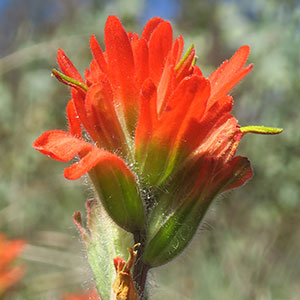Castilleja brevilobata
Castilleja gracillima
short-lobed paintbrush
slender Indian paintbrush, slender paintbrush
solitary or few, erect or ascending, unbranched, sometimes branched, hairs spreading, short, medium, and long, soft, short and medium ones short stipitate-glandular.
solitary, sometimes few, proximally creeping, becoming rhizomatous, erect to ascending distally, unbranched, sometimes branched, often glabrate proximally, hairy distally, hairs spreading, medium length and long, soft, mixed with much shorter stipitate-glandular ones near inflorescence.
green or ± yellow, lanceolate, elliptic, or oblong to narrowly ovate, 1–2(–2.5) cm, not fleshy, margins plane or wavy, involute, (0–)3–5(–7)-lobed, apex rounded to acute;
lobes ascending to erect, linear to lanceolate, apex rounded to acute.
green to purplish, linear-lanceolate to broadly lanceolate or narrowly oblong, 1.2–7.1 cm, not fleshy, margins plane, sometimes ± wavy, slightly involute, 0-lobed, apex acute to acuminate.
3–20 × 2–3.5 cm;
bracts proximally greenish to dull brown, distally red, orange-red, or scarlet, sometimes orange or yellow, broadly lanceolate or oblong, (0–)3–5-lobed;
lobes ascending, broadly to narrowly lanceolate, short, arising above mid length, apex acute, obtuse, or rounded.
4.5–18 × 1.5–6 cm;
bracts white, cream, pale yellow, pink, salmon, orange, or dull red throughout, or proximally greenish, distally as above, broadly lanceolate to oblong, 0–3(–5)-lobed;
lobes ascending to erect, lanceolate to triangular, often short, arising above mid length, apex obtuse or rounded, sometimes acute or acuminate.
straight, 15–24(–26) mm;
tube 12–16 mm;
beak exserted, abaxial lip equal to calyx;
beak adaxially green or ± yellow-green, 7–10 mm, puberulent, stipitate-glandular;
abaxial lip deep green, reduced, rounded, 1–2 mm, 10–25% as long as beak;
teeth incurved to erect, light green, 0.5–1 mm.
± straight, 19–30 mm;
tube 11–19 mm;
beak exserted from calyx, adaxially green, 7.5–11 mm;
abaxial lip deep green, reduced, 1–2 mm, 20% as long as beak;
teeth incurved to erect, green, 0.5–1 mm.
green or whitish with green veins, lobes colored as bract lobes or paler, 14–30 mm;
abaxial and adaxial clefts 5.5–8.5 mm, 30–40% of calyx length, deeper than laterals, lateral 1.5–4 mm, 20–25% of calyx length;
lobes oblong to narrowly triangular, apex obtuse to rounded.
colored as bracts, pigmentation often confined to lobes, 15–22 mm;
abaxial and adaxial clefts 7–14 mm, 40–50% of calyx length, deeper than laterals, lateral 2–6.5 mm, 10–20% of calyx length;
lobes narrowly triangular to narrowly lanceolate, apex acute (to sometimes acuminate in Logan Valley).
= 24.
= 48.
Castilleja brevilobata
Castilleja gracillima
Castilleja brevilobata is endemic to dry serpentine openings in the Siskiyou Mountains of southwestern Oregon and adjacent California. Although sometimes treated as part of C. applegatei or C. hispida, its morphology does not suggest a close connection with either. This species occasionally hybridizes with C. pruinosa in Del Norte County, California.
(Discussion copyrighted by Flora of North America; reprinted with permission.)
Castilleja gracillima populations are centered around the Greater Yellowstone region, but its range extends sporadically west to central Oregon. It is sometimes confused with C. miniata, but differs from that species in its floral dimensions, mostly single-stemmed growth form, primarily white, yellow, or pinkish orange bract coloration, puberulent stems, and weakly rhizomatous habit. Where the two grow in the same general region, there is no clear evidence of hybridization; however, C. cusickii and C. gracillima form an extensive, sporadically intergrading population in the Logan Valley, Grant County, Oregon.
Plants attributed to this species from the Rocky Mountain trench near the head of the Columbia River in southeastern British Columbia or adjacent Alberta are a combination of several other species, especially Castilleja lutescens and C. miniata.
(Discussion copyrighted by Flora of North America; reprinted with permission.)


